by Wallace Wyss –
I used to believe that, given enough different talents involved, a great car can be created.
Now I believe that it takes one dominant figure to make a great car; someone who has the force of will to override all those who do not have sufficient faith in the original conception.
So that explains my continued fascination with Carroll Hall Shelby.
He was a man who, by sheer perseverance and without much formal education, managed to create several automobiles, the most significant being the car called the A.C. Cobra.
He was born the son of a rural postman and a housewife on January 11, 1923, in East Texas.
His family wasn’t dirt poor but Shelby had to do odd jobs as a child, like picking cotton.
When he was a teenager, he fell in love with flying (guys like Lindbergh were heroes then) and joined up in the Army-Air Force before the war started. He wasn’t a college graduate so they put him in a program called “Flying Sergeants” where an enlisted man could be a pilot.
During the war, he spent the entire period in Texas, going from one base to another training pilots. After the war he returned home to Dallas where he became a cement contractor, and then later a chicken farmer.
THE FIRST SPORTS CAR
It was while Carroll Shelby was a chicken farmer he became interested in sports car racing and even tried to build a 200-mph sports car with a buddy in the buddy’s garage. That venture ended when the buddy’s wife put a stop to it.
He was doing well as a chicken breeder but then one day half his chickens died. While he was reeling with that problem, the other half died. He decided to quit that business but meanwhile a friend bought an MG TD and invited him to a sports car race. Now Carroll Shelby had never raced before but he got in that car and beat all the other MGs. So they put him in a class against faster cars and he beat them too.
Now there wasn’t much money to be made in sports car racing, it was a sport for gentlemen, you understand but there were ways to make money, like work for the sponsor. He soon had sponsors paying him to drive their sports cars and worked his way through a variety of marques such as Allard, Porsche, OSCA, Jaguar, Corvette and on and on, fifty different marques in all. He was very successful in Ferraris and Maseratis.
His first “sponsored ride” from an automaker was from Aston Martin, who had him drive factory race cars in Europe. Now part of their motivation might have been to have their marque be more well known to Americans but I think they hired him because he was known to be “steady at the wheel” and not drive a car to destruction (I think that in turn came from his test pilot days when if you flew a plane “beyond the envelope” so to speak, you died).
He was a cautious driver. Later in life he claimed Enzo Ferrari asked him to drive for him three times and he turned him down each time, wary of how drivers got killed trying to drive beyond their ability to please the old man.
As a race driver, he was above average but not the best there was. But in business, he excelled again and again. Shelby also tied in with the brother of car racer Jim Hall to open a sports car dealership. They had some used Ferraris and were appalled at the prices of parts so one venture they tried was having Corvettes rebodied in Italy. But only three “Scaglietti Corvettes” were made before GM cut them off from chassis.
It’s worth mentioning that, rather than be ashamed of his humble roots as a failed farmer, Shelby capitalized on it. Once on his way to a race, Shelby had to wear his overalls from the farm to make the start time. When his odd racing attire netted him more attention and publicity than the winner of the race got, Shelby made the striped bib coveralls his trademark. He rapidly progressed up the sports car ladder until an Englishman, John Wyer, invited him to drive a factory Aston Martin.
He did well with their cars finally, in 1959, winning the 24 Hours of Le Mans for them. For MG, he set land speed records at Bonneville Salt Flats. Twice, he was named Sports Illustrated’s “Driver of the Year.”
CARROLL SHELBY WAS HIDING A HEART PROBLEM
But Shelby had a secret. He had a bad heart even as a child, spending a couple years bedridden. When he became an adult he was diagnosed with angina, but managed to hide the problem as a racer, chewing on nitroglycerine pills to get through each race. One time in 1960 he had just bit into his fifth pill for the race when he decided he couldn’t take it any more, pulled into the pits and hung up his helmet.
He decided that he had enough experience in enough different cars. It was time to put that experience to work doing his own sports car.
His first idea was to take Austin Healeys, jam a Chevy into them and make a reliable fast car. But Donald Healey said “No thank you” as his cars were selling just fine with four and six cylinder engines.
Carroll Shelby then heard that A.C., the makers of a fine sports car in England called the A.C. Ace, had lost their engine supplier of in-line sixes, Bristol. They were making do with a Ford six but Shelby thought the car was just right for an American engine. Now Chevy had already turned him away once, so as luck would have it, a Ford engineer told him Ford was introducing a lightweight V8, 221 cu. in. and promised to send him one.
Shelby bought an A.C. Ace and set up a shop to jam the Ford V8 into the A.C. He sent the car back to England and then flew over and took it to a racetrack and demonstrated it to A.C. Now here’s where the Texas charm came into play. He charmed A.C. into thinking Ford was bankrolling him and charmed Ford into thinking A.C. was bankrolling him. Ford did finally cut a check for $25,000, hoping he would go away but no, he immediately ordered two more chassis.
By that time the engine size jumped to 260 cubic inches and the new car had a name: Cobra.
The first car, the one carrying the serial number CSX2000 was introduced at the New York Auto Show in 1962. It turned the sports car world on its ear. And recently sold in 2016 for over $13 million dollars.
Chevrolet even sent some Z06 Corvette coupes out to the coast where they whomped the first Cobra in a race but it was an illusionary victory, because from that point on, the Cobras kicked Corvette butt.
Shelby not only had Ford bankrolling Cobra production but got them to fund a racing team, and soon Cobras were racing in the U.S. and Europe.
In 1965, they won the FIA sports car world championship.
LEMANS WIN A GOAL
But Ford only liked the Cobra because they could use Shelby’s name to sell “Cobra parts” and get rub-off on their other cars. The real goal of Henry Ford II was to win the 24 hours of Le Mans which the Cobra couldn’t do. Ferraris had won seven years in a row and it was obvious you needed a 200-mph car to take them on.
Ford developed their own 200-mph GT race car to do that, the GT40, but the first year they ran it without Carroll Shelby and fell flat on their faces. Hat in hand, they came to Shelby and got him to make the car right and ’65 was a trial and error year, where one solution was to go big block. In ’66 they won Le Mans.
Meanwhile since ‘65 Shelby had been making the Shelby Mustang. These were the premium high performance cars in Ford showrooms. Chevrolet responded with the Camaro and ’67 saw the beginning of Trans Am racing where the two firms were evenly matched on the track and eventually Shelby’s Trans Am cars lost to the Roger Penske team’s “steamroller.”
Ford had developed the Boss 302 and had Shelby race some, but saw that with that car, they could began to phase out the Shelby Mustangs. The last AC Shelby Cobra was built in ’68, the last Shelby Mustang in ’70.
SHELBY MOVES ON
Shelby always wanted to be a big game hunter in Africa and after severing his ties with Ford went off to Africa and indeed had a game preserve.
That ended in a dispute over hunting rights and he came back without knowing what he wanted to do, so he started accessory companies, making mag wheels and the like.
Finally his old buddy from Ford, Lee Iacocca, called him and said he was over at Chrysler and would Shelby come over and make some exciting Chrysler cars?
That started the small pocket rocket Shelbys, front wheel drive, and for a few years they got some excitement going. But the only Cobra like car to come out of the Chrysler venture was the Viper, which was a real hairy car to drive, almost as scary as driving a 427 Cobra. Both cars had a tendency to go hog wild if you floored them from a standstill.
Shelby left Chrysler when his patron, Iacocca, retired and kept busy with three ranches, raising horses and cattle, and still had the race tire distributorship in Gardena.
But then he got seduced with the idea of making replica Cobras.
I’d like to take credit for turning him on to that idea by sheer accident. One day around 1970 I saw a real 427 Cobra on the freeway and chased it for ten miles until the owner drove to his house and angrily asked why I was following him.
I explained and he agreed to let me set up a photo session for a German magazine. I called Carroll Shelby and asked if he’d pose with the car. Shelby was a bit mystified, he couldn’t figure out why in Hades anybody cared about his old cars. He posed with a cowboy hat and I sold the story.
About that time, maybe a little later, all these replica makers began churning out replicas of Cobras, without giving Shelby a dime, and it just got to him. He began making his own.
At one point he claimed he had found some uncompleted chassis but after the DMV in California began asking for proof of when those had been made he moved to Nevada. Over there, he didn’t emphasize the availability of “continuation cars” and instead sold replicas with new CSX (Carroll Shelby Experimental) serial number series so you would know they weren’t the original CSX2000 or CSX3000 series cars (accounts differ on how many of the uncompleted cars he completed, some say as many as 13).
While in the midst of making kit cars, he made an almost fatal mistake, business-wise, thinking he could make a modern car that met all the regulations (which kit cars didn’t have to meet since they were called “self assembled cars.”). That became the Olds-powered Series I and it was a bomb, a total dud and the company went broke. Shelby only escaped with part of his savings as a result of using clever Wall Street advice on how to go broke and come back again.
THE RETURN OF THE NATIVE
But Shelby emerged with some of his millions intact and continued with the kit cars. Finally Ford, realizing that Shelby was still a great name to promote with, called him in as a consultant on the 2005-‘6 Ford GT. From there it was only natural to bring back the Shelby Mustang as a 2007 model and those continue to be built to this day.
Shelby had a heart transplant more than once. His close brush with death led him to create the Carroll Shelby Foundation dedicated to providing medical assistance for those in in need, including children.
He endured both heart and kidney transplants in the last two decades of his life.
What I remember him for is that he was always an innovator and pioneer and no matter his physical ailments, he’d pick himself off the bed and press forwards. I ran into him everywhere—on California race tracks, in Monte Carlo, in Detroit. He traveled the world, socialized with movie stars and beauty queens, made and lost numerous fortunes, won races, built cars and lived large.
He died May 10, 2012 at age 89 at Baylor Hospital in Dallas.
Shelby was survived by his three children from his first wife, Patrick, Michael and Sharon, his sister, Anne Shelby Ellison of Fort Worth, six grandchildren, six great grandchildren and his last wife Cleo.
THE AUTHOR: Wyss’ biography of Carroll Shelby is still available from Enthusiast Books,Hudson, WI. The above portrait of Shelby will be available on his art website wallacewyssfineart.com.
Let us know what you think in the Comments.

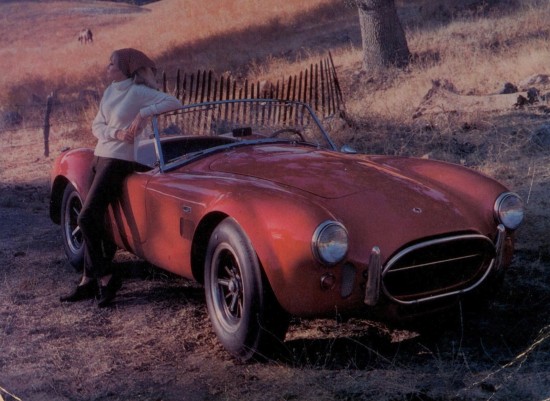
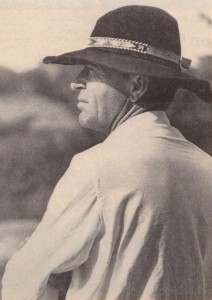

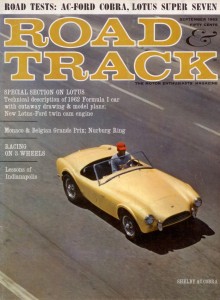
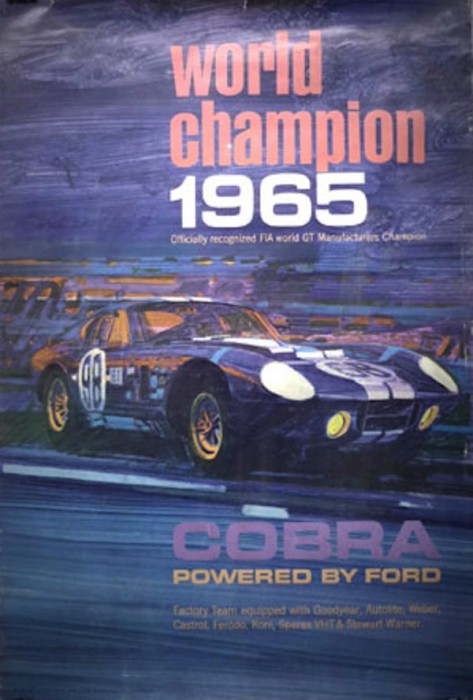
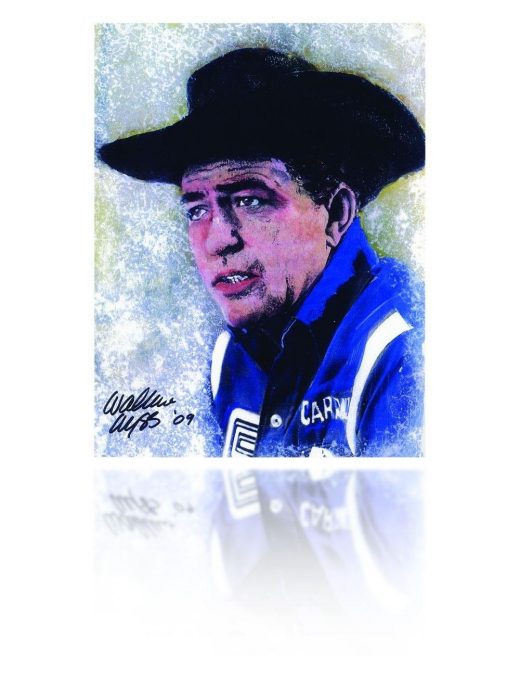
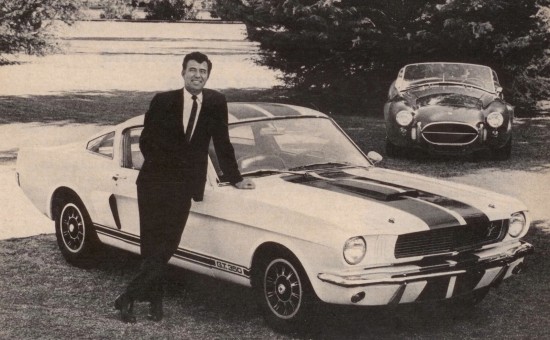
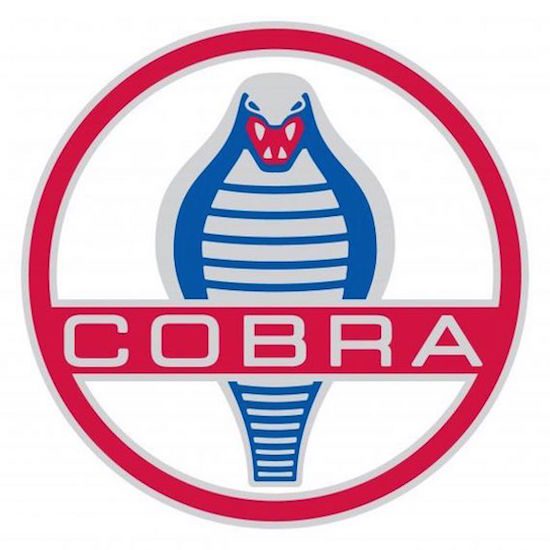
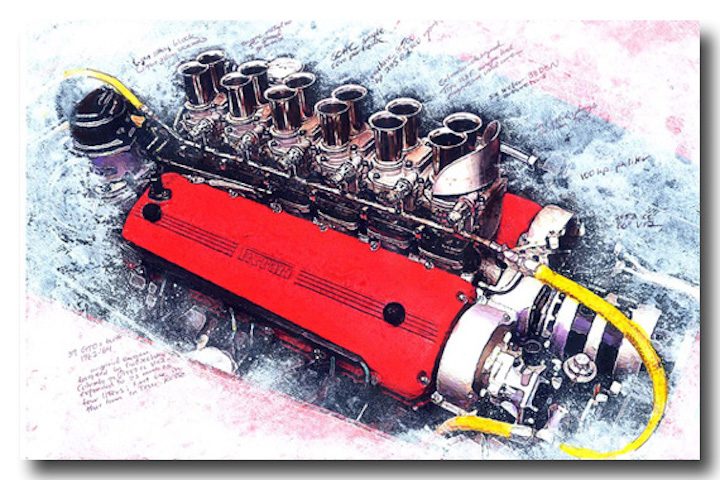

Nice article Mike. Most people don’t realize that Shelby’s first choice for engines was Chevrolet and that the Scaglietti Bodied Corvette’s were actually Shelby’s first attempt at a production car, pre-dating the Cobra by 3 years. From a conceptual standpoint, his idea of mating a powerful/dependable American engine with a lightweight European body started with the 3 Scaglietti Corvette’s not the Cobra. The aluminum Scaglietti bodies were almost 400lbs lighter than a standard Corvette body and the 283 was one of the most powerful engines of its time.
GM execs killed the project due to the AMA racing ban. Shelby knew he would never get the 100 chassis’ he needed for homologation purposes and moved on. Shortly thereafter Ford came out with their thinwall engine and the rest is history.